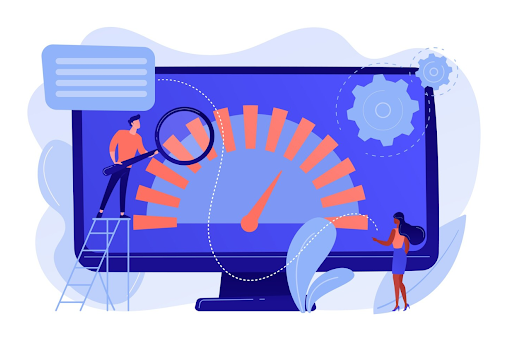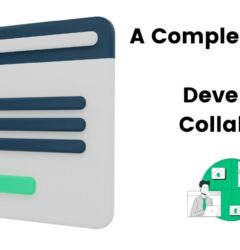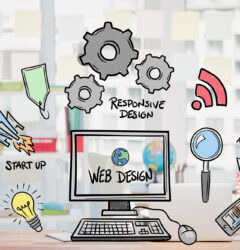Incorporating AI into Web Development and Design QA
12 Jun

Table of Contents
ToggleAccording to this Stanford report, AI has made significant progress in various fields, including speech recognition, natural language processing, media generation, and more, in the last five years.
Today, AI has slowly begun to integrate itself into the daily human experience, including web development and design QA.
One of AI’s breakthrough areas is quality assurance. With artificial intelligence and machine learning, entire development teams can streamline their processes and create better end products overall.
The Importance of Quality Assurance in Web Development and Design
Quality assurance, or QA, is integral to the web design and development process. Even in non-tech sectors, quality remains a primary driving force of most activities—the same goes for tech-based spaces like web development.
QA in web design and development impacts specific metrics such as:
- Website Usability
- Responsive Design
- Performance Optimization
- Cross-browser Compatibility
- Security and Data Protection
A good quality assurance team should be able to assist development teams in creating a user-friendly and intuitive website. By performing the necessary steps to ensure a website works as intended, QA teams ensure end users are satisfied with the website.
Quality assurance is critical in web development and design because websites are primarily customer-facing. QA testers must know what their target market looks for in a web platform and how to design the website to cater to customer needs.
[Free Checklist]
Website QA Testing Checklist
Grab your free copy of the Website QA checklist in Excel. Save time and leave no website element untested.
DownloadAI in Web Development and Design QA
Let’s explore how we can use AI-enabled technologies, such as machine learning algorithms and natural language processing, to assist with quality assurance in web development and design.
Automated Testing with Artificial Intelligence
As you can imagine, testing software is a significant aspect of what a quality assurance team does. Pre-AI, QA teams had to use a combination of manual and automated methodologies to test software. Understandably, this repetitive process often took a lot of time and resources to complete.
With AI, QA teams are empowered to work faster and achieve more consistent results with less effort than before. Some benefits of AI in automated testing include:
- Increased Test Efficiency. Automated testing tools execute tests much faster than manual testing. As a result, QA teams can cover more test cases in less time and speed up the testing process overall.
- Improved Accuracy and Consistency. Human error is inevitable in quality assurance, thereby reducing the reliability of results. With AI, QA teams can perform repetitive tasks with relative precision, ensuring test results are reliable when done across multiple test runs.
- Early Defect Detection. Identifying defects early in the development cycle has numerous benefits. AI-enabled testing tools can inspect changes in code to determine where defects have the highest probability of occurring, allowing QA teams to prioritize their testing efforts in high-risk areas.
- Scalability and Flexibility. Automated testing using AI allows QA teams to adapt to complex development projects without too much manual intervention. With diverse test cases, QA teams can perform tests even on large projects using more or less the same resources.
- Continuous Improvement. One key element of AI that makes it so powerful is its potential for growth. AI-enabled testing tools can pull from past testing experiences and adapt to improve test coverage and efficiency over time. The more a QA team tests, the better their results will eventually become.
The future of quality assurance, no doubt, lies in automated testing. However, it’s important to be aware of the potential risks and challenges of AI. For instance, AI can be vulnerable to adversarial attacks, where malicious actors exploit the system’s weaknesses.
By incorporating AI into web development, quality assurance teams have the potential to become more resource-efficient, all while maintaining (or even improving) their quality of work.
Accessibility Testing
Accessibility testing has slowly begun to take a more significant role in web development and design. As digital spaces continuously become more a necessity than a novelty, everyone, including disabled people, should have access to web-based resources.
AI, in particular, helps contribute to a QA team’s capacity to find and fix defects, specifically with accessibility in mind. Some of the ways AI contributes to accessibility testing are the following.
- Automated Accessibility Testing. QA testers can use AI-driven tools to scan web pages for missing alternative text, lack of keyboard navigation support, and insufficient color contrast, among others.
- Image Recognition and Alt Text Generation. AI tools can automatically generate descriptive alternative text by analyzing images on a web page. While this step may not necessarily be delegated to the QA team, testers who find deficiencies in a webpage’s alternative text can accelerate their process through generative AI.
- Natural Language Processing for Accessibility. NLP techniques hinge on the concept of content being written in a clear and understandable manner. Using NLP in accessibility testing has to do with ensuring text content on a website is free of jargon or intricate language structures that may reduce comprehension.
- Screen Reader Compatibility Testing. Users with visual impairments may rely on screen readers to access content on the web. AI-driven testing tools can be used to simulate the behavior of assistive technologies to identify deficiencies within a web page. That is, AI can be used to determine if there are any navigational difficulties or issues with properly exposed content.
Compliance Reporting. Compliance is a vital aspect of any good web development project, especially when it comes to accessibility. AI-based testing tools can constantly monitor webpage content for accessibility issues and highlight areas that aren’t compliant with standards or regulations.
Load Testing
Load testing is a kind of performance testing that simulates certain conditions, such as high user traffic or workload. Its primary purpose is to assess web performance under duress.
A web page or web app working with a few users online does not necessarily translate to smooth use if there are hundreds of people on the site at the same time. Testers typically watch the following metrics during load testing:
- Response time
- Throughput
- Resource Utilization
- Overall Stability
As expected, load testing is an essential aspect of web development and design QA as it determines whether or not a web page holds under pressure. AI can help QA teams streamline this process through:
- Predictive Performance Analytics
- Dynamic Test Parameter Optimization
- Anomaly Detection and Root Cause Analysis
- Continuous Performance Monitoring
- Test Result Analysis and Reporting
With AI-driven load testing, development teams can determine performance issues early in the development cycle, thereby improving user experience and satisfaction.
[Free Checklist]
Website QA Testing Checklist
Grab your free copy of the Website QA checklist in Excel. Save time and leave no website element untested.
DownloadImproving User Interface and Experience while Incorporating AI in Web Development
In any web development project, user interface and experience play integral roles in how a development team decides to map out their processes. Users today increasingly demand intuitive and engaging digital experiences, and it can be quite a challenge for development teams to adhere to those standards.
Quality assurance teams, in particular, have to pay specific attention to how web pages perform based on a user’s perspective. While good UI/UX patently begins with an excellent designer, it is a team effort to get a web page to perform optimally.
Incorporating game art services into the design process can significantly enhance the visual appeal and user engagement of web interfaces, making them more attractive and immersive. Game art services bring a creative edge to UI/UX design, infusing elements that capture user attention and improve overall interaction with the digital environment.
Similarly, website personalization examples illustrate how tailored experiences can further deepen user engagement.
Artificial intelligence can help with areas such as:
- Personalization;
- Natural Language Processing;
- Visual Recognition and Image Processing;
- Predictive UI Design;
And a lot more. QA testers don’t just have to worry about the technical backdrop of a web page; they also have to pay close attention to how users will potentially perceive and interact with the product.
A WordPress development company can leverage artificial intelligence to enhance personalization, improving user interaction with websites. Additionally, WordPress might incorporate natural language processing to make websites more accessible and user-friendly
Challenges with Incorporating AI into QA
Of course, while AI has numerous benefits when used in an efficient QA team, testers still face several challenges regarding adoption.
Skills Gap
Using artificial intelligence provides organizations with a considerable advantage over competitors. However, despite AI’s now mainstream popularity, it remains a challenge to recruit QA talent with specialized knowledge in areas like machine learning and data science.
As a result, organizations may be hard-pressed to implement AI technology into their QA process because of skill deficiencies. Maintaining AI-powered QA systems requires technical skills that the average QA tester might not have.
Furthermore, skilled testers who can utilize AI in the QA process usually have more competitive compensation packages than other testers. Organizations with limited resources may find that AI integration in QA can be quite a challenge.
Colin McDermott, Head of SEO at digital product ecommerce platform Whop says, “AI has allowed our web development team to build faster and has improved our QA processes. However incorporating AI into a development flow comes with its own challenges, and can mean we have to check that code hasn’t been taken from other projects without proper attribution.”
Cost and ROI
Staying on the topic of costs, implementing any AI-enabled system has significant upfront costs. Even a large organization with some financial leeway will still have to carefully weigh the pros and cons of integrating AI into its QA system.
Organizational leaders must thoroughly evaluate the potential ROI and sustainability of AI initiatives in QA in order to show just cause for making such a significant investment.
Adoption and Cultural Transformation
Even if a company has sufficient resources and has acquired the right talent to facilitate the integration, there’s still the issue of adoption. Integrating any new piece of technology into a process is going to be a challenge—even if that piece of technology helps a team progress faster.
Realistically, QA team members would have to unlearn what they already know, which can be challenging without the right management strategies.
When incorporating AI into web development and design, organizations must change more than just the technology itself. They must also facilitate cultural and organizational changes. Management is then tasked with ensuring the technologies they hope to improve processes will actually be utilized in the organizational workflow.
Management can accelerate adoption through the following:
- Training and workshops
- Innovation challenges
- Cross-functional collaboration
- Peer learning and knowledge sharing
- Mentorship and coaching
Future Trends and Opportunities
As artificial intelligence becomes a more pivotal aspect of human existence, AI technologies will continue to advance even more rapidly.
Consequently, organizations will also have to adapt the way they develop, test, and maintain web applications. Here are a few trends and opportunities in the field to watch out for:
- Autonomous and Self-Learning Systems. Self-learning systems are able to learn from test data and user feedback, ensuring improved accuracy and efficiency in the long run.
- AI-powered Code Generation. Developers can leverage AI to automate routine coding tasks, leaving more time and resources to generate cleaner code.
- Generative Design. AI-driven creativity tools are becoming more commonplace, enabling developers to generate UI layouts and visual elements through AI.
- Augmented Reality Testing. AR testing will enable developers to test user interactions in virtual environments, allowing them to validate functionality and performance.
- Hybrid Human-Machine Collaboration. As AI becomes more adept at augmenting human creativity, QA teams will be able to focus on more high-level tasks such as innovation and strategy.
Conclusion
AI is unquestionably here to stay. It makes QA teams more efficient and consistent and yields better overall results. Plus, automation in web development and design QA will only become more prominent as AI technology becomes more sophisticated and accessible.
AI’s benefits don’t stop at the QA team, either. As direct beneficiaries of quality work, end-users can access fast, reliable, and, most importantly, intuitive web-based projects.

Author’s bio:
Roy Emmerson is the co-founder of TechTimes.com, a B2B SaaS platform that helps businesses stay up-to-date on the latest technology trends. With over a decade of experience in the tech industry, Roy is a thought leader in the field and is passionate about helping companies embrace new technologies to improve their operations and drive growth.
Recent Posts
- Best Practices for Efficient Document Reviews and Collaboration December 18, 2025
- MEP Document Management: How to Streamline Reviews & Avoid Rework October 3, 2025
- What Is Online Proofing Software? And Why Content Review Breaks Without It July 11, 2025
- How Laerdal Medical Cut eLearning Review Time by 50% with zipBoard’s Visual Review Tool July 9, 2025
- Why Your Team Needs a Content Feedback System (Not Just Comments in Docs) May 28, 2025
©️ Copyright 2025 zipBoard Tech. All rights reserved.



